During the Period of
Independent Lithuania
(1918- 1940)
Society and Economy
When the German occupation ended after the war and
the Lithuanian state was established, Vilkovishk 's Jews started to
return home. The economic situation of the returning residents was
very bad and they needed help. A Jewish relief committee was
established in Vilna which provided financial help to needy
communities in Lithuania (see attached document written still in
German - Wladislawow is the old name of Kudirkos Naumiestis).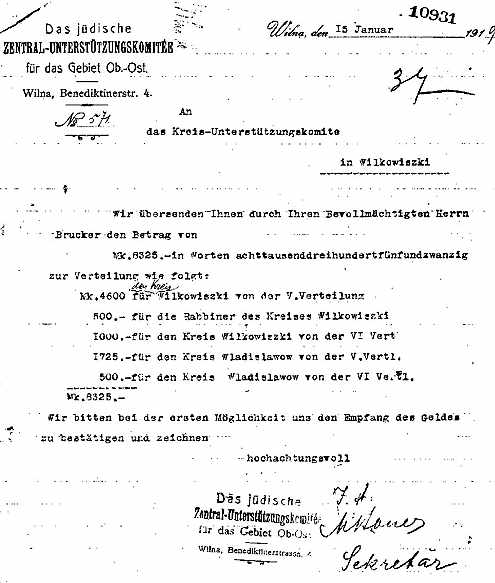
The autonomy law issued by the government regarding minorities in Lithuania, including Jews, gave substantial encouragement to social and economic life. Elections for the community committee took place in 1919 and the two workers parties, "Poalei Zion" and the "Bund" won an absolute majority. The first meeting of the committee took place on December 30, 1919, with Misler being elected chairman, and because the protocols were written both in Hebrew and in Yiddish, Bilotsky was elected as the Hebrew secretary and Guterman.as the Yiddish secretary
(see below for the document written in Hebrew).
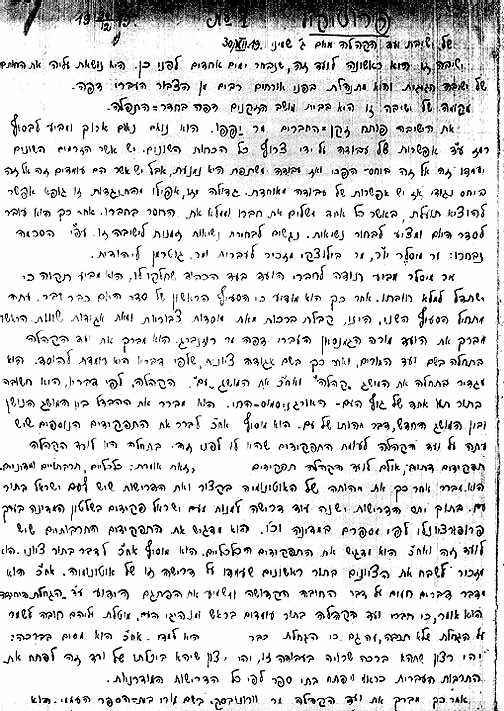
In these years the signs on Jewish shop were written in Lithuanian and Hebrew or Yiddish, but after a short time they were smeared over at night with tar.
The committee was active until the end of 1925 when the autonomy was annulled by the nationalist government who took over the rule in the state. During the years of its existence the committee collected taxes as required by law and was in charge of all aspects of community life.
At the elections for the municipal council, which took place in 1921, 11 Jews out of 21 council members were elected, in the 1924 elections there were 12 Jews in a council of 24 members, and a Jew officiated as Chairman of the District Council. In 1931, 8 out of 12 council members elected were Jews: Avraham Liudvinovsky, Bendet Rabinovitz, Shlomo Reizen, Ya'akov Rozenholtz, Reuven Haskel, Yosef Kabaker, Avraham Makovsky and Mordechai Zimansky. But in the 1934 election only 6 Jews were elected, out of 12 council members. Meir Varshavsky, the Deputy Mayor and treasurer of the municipality for many years, was also a Jew. In 1936 there were 7 Jews among the 19 employees of the municipality. Among 110 government officials there was 1 Jew.
According to the first survey arranged in Lithuania in1923, there were 7,263 people in Vilkovishk, including 3,206 Jews (44 %).
When conditions stabilized the Jews started to rehabilitate their businesses and to establish new enterprises, but the town did not return to the status it had before WW1. The brush industry, which had maintained hundreds of families, became more and more restricted, until by 1935 this branch only employed about 50 workers, who also suffered from labor conflicts with their employers. The reason for this crisis was the shortage of raw materials in Lithuania and the prohibition of export by the USSR, who was the main supplier of bristles.
Another reason for the deterioration of Vilkovishk 's economy was the construction of the railway line Kazlu Ruda-Marijampole-Kalvarija- Alytus, which transferred economic activity from Vilkovishk to Marijampole. The annulment of the autonomy and the seizure of rule by the Nationalist party in 1926 also caused a deterioration of conditions for Jews in Vilkovishk. The new rule encouraged the establishment of Lithuanian consumer cooperatives in order to compete with the Jewish merchants and also imposed heavy taxes on them. The total closure of the border with Poland cut off trade with this country and land reform which was carried out by the government took away part of Jewish owned land, adding to the worsening of economic conditions of Vilkovishk 's Jews.
Despite this the Jews established new enterprises, such as for the extraction of oil, for soap, cigarettes, a flour mill, a printing press etc., and with all the difficulties the number of Jews in Vilkovishk did not decrease. Only a part of the youth immigrated to Eretz Yisrael or moved to other towns in Lithuania.
According to the 1931 government survey of shops in the state, Vilkovishk had 154 shops, including 130 owned by Jews (84%). The partition according to the type of business is given in the table below:
|
Type of the business |
Total |
Owned by Jews |
|
Groceries |
14 |
13 |
|
Grains and Flax |
11 |
10 |
|
Butcher's shops and Cattle Trade |
17 |
12 |
|
Restaurants and Taverns |
19 |
10 |
|
Food Products |
9 |
9 |
|
Beverages |
6 |
6 |
|
Textile Products and Furs |
22 |
21 |
|
Leather and Shoes |
9 |
9 |
|
Tobacco and Cigarettes |
1 |
1 |
|
Haberdashery and Home Utensils |
11 |
11 |
|
Medicine and Cosmetics |
4 |
2 |
|
Watches, Jewels and Optics |
3 |
3 |
|
Bicycles and Sewing Machines |
2 |
1 |
|
Tools and Steel Products |
6 |
6 |
|
Building Materials and Furniture |
2 |
2 |
|
Heating Materials |
8 |
8 |
|
Overland Transportation |
3 |
2 |
|
Stationary and Books |
2 |
1 |
|
Miscellaneous |
5 |
3 |
According to the same survey Vilkovishk had 50 light industry factories, 42 of them owned by Jews (86%), as can be seen in the following table:
|
Type of the Factory |
Total |
Jewish owned |
|
Metal Workshops, Power Plants |
3 |
2 |
|
Headstones, Bricks |
1 |
0 |
|
Chemical Industry: Spirits, Soaps |
4 |
4 |
|
Textile: Wool, Flax, Knitting |
2 |
2 |
|
Tar Industry |
1 |
0 |
|
Paper Industry: Printing Presses |
2 |
2 |
|
Beverage. Cigarettes |
13 |
10 |
|
Dresses, Footwear |
5 |
5 |
|
Leather Industry: Production, Cobbling |
2 |
2 |
|
Barber Shops and others |
17 |
15 |
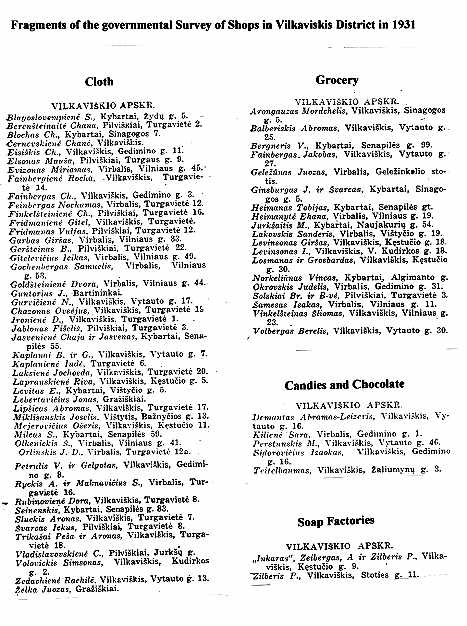
By 1937 Vilkovishk counted among its working population 87 Jewish artisans, as follows: 16 tailors, 11 bakers, 10 butchers, 10 barbers, 7 shoemakers, 4 hatters, 3 watchmakers, 2 seamstresses, 2 painters, 2 tinsmiths, 2 leatherworkers, 2 stitchers, 1 rope maker, 1 carpenter, 1 photographer, 1 oven builder, 1 glazier, 1 electrician and 10 others. Most of them were organized in "The Association of Jewish Artisans" which had a club and a loan fund.
In addition to the merchants, industrialists and artisans there were 35 families engaged in agriculture. There were also 7 buses, 3 of them owned by Jews, and out of the 4 taxis 1 belonged to a Jew (in 1935).
As from 1926 the manager of the power station owned by the municipality was the Jew Meir Varshavsky, who was praised for his work, as well as a Jewish mechanic who worked in the station. At the end of 1935 both were dismissed, the employers using the excuse of "restrictions". The district engineer was also Jewish.
An important factor in the economic life of the town was the "Volksbank" established with the help of the "Joint" in 1928, when it had 718 members. By 1935 it had only 368 members: 79 shop owners, 56 artisans, 48 merchants, 37 workers, 32 free profession owners, 31 agrarians, 21 cart owners, 12 industrialists, 8 clerks and 44
miscellaneous members. The capital of the bank was then 55,000 Litas (1$=6 Litas). Loans to the amount of 300,000 Litas were given and the total sum of deposits came to 170,000 Litas. Wholesalers used the services of the private bank of Yosef Sperling.
In 1939 there were 190 phone owners in town, 64 of them belonging to Jews and Jewish institutions.
Education and Culture.
Instead of the traditional educational system of "Chadarim" and "Talmud Torah" a modern Hebrew educational chain was established. It included a kindergarten, an elementary school of the "Tarbuth" network, a religious school of the "Yavneh" organisation and a high school.
The high school was established in 1919 at the initiative of a founders committee whose members were intelligent Jewish merchants, advocates of the Hebrew language who cared for the education of their children. They were Ya'akov Chmilevsky, A.Zeiberg, A.Volberg, Ya'akov Solomin, Peretz Silver, Yosef Sperling, Shimshon Volovitzky, Neta Teitelbaum and Neta Matz.
In August 1919 hundreds of children started their studies in this high school, where all subjects were taught in Hebrew with Sephardi pronunciation. The first director was Dr. M.Cohen and after him came Dr.Tsemach Feldstein, Dr.Yehoshua Fridman, Dr.Moshe Yardeni, Shlomo Trachtenberg, the last director being Shraga Halperin.
Among the teachers were M.J.Mendelson-Mishkutz, Dr.A.Rozenberg, B.Meshorer, Dr.Yehudah Holtzman-Haetzyoni, J.Strelitzky, D.Zilberstein, A.M.Tshertok and others.
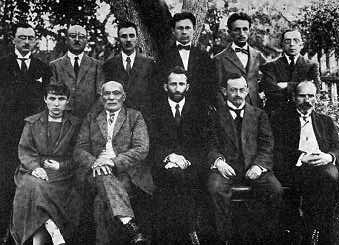
The teachers of the Hebrew High School
Sitting from right: B.Meshorer; Dr.Cohen; Dr.Tsemah Feldstein; Dr.Y.Haetsyoni; Lithuanian teacher.
Standing from right:Y.Zilberstein; -----; M.Y.Mendelson; -----; Shimon Zak; Hayim Vilkovishky.
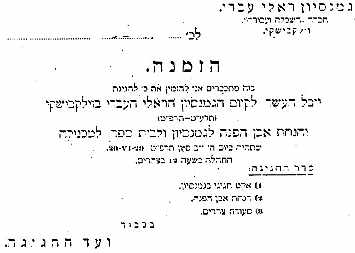
The invitation for the celebration of the tenth
anniversary of the High School and the laying of the cornerstone for
the new building of the High School and the Vocational School, June
20, 1929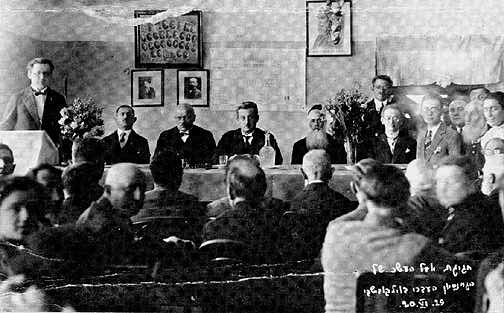
The tenth anniversary of the Hebrew High School
Sitting from right: A.Volovitzky (delegate of the pupils); Dr. Cohen (Teacher of Science); Rabbi Grin; Dr.Sakenis (Education Minister); Head of the department of high schools in the ministry; Dr. Yardeni ( headmaster); Y.M.Mendelson (lecturing).
The first graduation class completed its studies in 1921 and the Lithuanian government representative at the matriculation examinations was Dr.Yosef Berger (Harari), the director of the Education Department of the Jewish ministry. This was the only occasion during the Jewish autonomy in Lithuania when the government authorized a Jew to participate in the matriculation examinations and to sign matriculation certificates on its behalf.
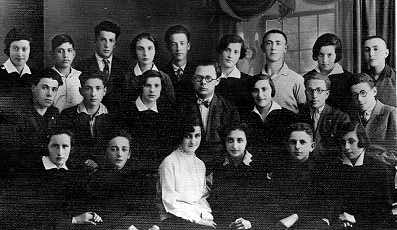
A class of the high school 1926 or 1927
First line sitting from left: Nechama Openheim, Ya'akov Cohen, Rachel Michnotzly, Sheine Stalovsky, David Feinberg, Frida Melamdovitz
Second line sitting from left: Aryeh Balberishky, Shmeriyahu (Zunia) Pustopedsky, Nechama Rabinovitz, Teacher Mishkutz, Sarah Neishtot, Goldshmit, Imanuel Albom.
Third line standing from left: Shifrah Sider, Mordechai Shershenevsky,
Hayim Srolevitz, Yehudith Shperling, Alter Hayat, Frida Hayat, Reuven Levin,
Hanah Tchernotzky, Meir Tabatchnik.
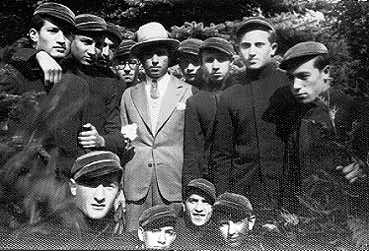
High School Class with the gymnastics teacher Starkovsky - 1931
The school was financed by tuition fees paid by the pupils, but due to the deterioration in the economic situation of Vilkovishk Jews many of them had difficulty in paying the high fees. For several years the Lithuanian government supported the school, and in 1929 the cornerstone for a new building of the High and the Vocational schools was laid (see the invitation for the celebration below). The building was erected thanks to donations of a Vilkovishk Jew who had immigrated to London named Krovelsky of the "Joint" organization, and of the Sobolevitz Brothers from Vilkovishk. The new building housed both the High and Vocational schools, where subjects of metal and electricity were taught. The vocational school was connected to the "ORT" network and teaching languages were Yiddish and Hebrew.
In the middle of the thirties, after the Nazis seized power in Germany, a group of Jewish youths from Germany arrived at the school to learn a vocation prior to their "Aliyah" to Eretz Yisrael
The director and teacher of this school was for several years (1929- 1933) Aryeh Volovitzky, born in 1908 in Vilkovishk. He immigrated to Eretz-Yisrael, where he changed his name to Ankorion. He was a lawyer (Dr. Jur.) and worked in the public sector, later being elected to the "Kneseth" on behalf of the Israeli Labor party.
Many of the graduates of the high school continued their studies in the Lithuanian University in Kovno and also abroad. Some of them immigrated to Eretz Yisrael where they became doctors, lawyers, teachers, merchants, Kibbutz members etc., all loyal to Jewish culture and to the spirit of Lithuanian Jewry.
In 1935 there were 120 pupils in the high school, its conditions worsening from year to year, but none the less it existed until Soviet rule in Lithuania in 1940.
In Vilkovishk two Hebrew books were printed: "Speak Hebrew - about the question of Speaking Hebrew", by M.Yardeni 1932, and "The History of the new Hebrew Literature, Vol. 1, the ‘Haskalah’ literature in Central Germany (1784-1829)" by Ch.N.Shapira, 1940, a lecturer of Judaica in the Lithuanian university, who was murdered by the Nazis in the Kovno Ghetto).
In the years 1918-1919, at the initiative of the "Bund" and "Poalei Zion-Smol" who dominated the community committee, many cultural institutions were established. They organized the "Kultur Lige" (League for Culture), a popular university, a Yiddish school, a consumer cooperative, the trade union of the brush workers, which became the center of all brush workers in Lithuania and also a sick fund. All these institutions existed till 1926, when they were closed together with the liquidation of autonomy, when the nationalist party began to rule in Lithuania.
In 1925 a branch of the association "Libhober fun Visen" (Supporters of Knowledge) was founded in Vilkovishk, which established a library with 1,500 books in Yiddish. Next to it was a reading room where lectures on different themes took place. There was also the Zionist-Socialist "Sirkin Society", which maintained a large library in Hebrew and Yiddish.
The Jewish theater from Kovno often presented its plays and so did the "Hebrew Studio", which existed only for a few years.
In March 1939 "The Artisans Association" arranged a big party in the big hall of the cinema, where the play "Two Kuni Lemel" was performed with great success.
There was also "The Society of Jewish ex-soldiers who fought for the independence of Lithuania" with its 25 members.
Zionist and Other Activities.
During the autonomy the workers parties "Bund" and "Poalei Zion" dominated the Jewish public. At the head of the "Poalei Zion" party stood Efraim Bruker and his wife Rashel, the accountant Album and Yisrael Nitzevitz.
A delegate from VILKOVISHK participated in the regional conference of "Poalei-Zion" which took place in Suvalk in 1919.
The "Bund" was forced to stop its activities in 1921, where some of its members merged with the underground Communist party and others with the "Poalei Zion-Smol (Left)", which too was forced to disband after the nationalist party took over in Lithuania.
From the entire Yiddishists group in Vilkovishk there remained only the "Volkists" (populists), who stood for the use of the Yiddish language and opposed Zionism. Their organ of opinion was the daily newspaper "Volksblat" published in Kovno.
In those years the Zionist Vilkovishk with all its nuances became the dominating movement among VILKOVISHK Jews. All Zionist parties were active there: Z"S (Zionist-Socialist), Z"Z (Tseirei Zion) from the labor movement; the General Zionists; Mizrachi; Revisionists; WIZO (Women International Zionist Organization). The Zionist youth organizations who were avtive were: HeChalutz, HaShomer HaTsair, Betar.
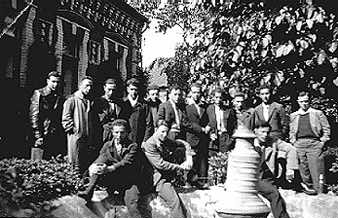
Meeting of the "General Zionist HeChalutz" in Vilkovishk May 19, 1934
On the left side is the front of the Jewish "Home for the Aged"
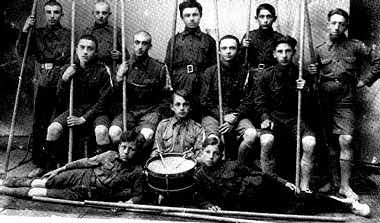
Group "Pil" of "HaShomer HaTsair" 1925
One can judge the state of mind among Vilkovishk Jews according to the results of the elections for the first Lithuanian Seimas (Parliament) which took place in October 1922: Zionists received 609 votes, Achduth (religious) 290 votes, and Democrats 92 votes. In the table below we can see how Vilkovishk Zionists voted for the different parties at six Zionist Congresses:
|
Congress Nr. |
Year |
Total Shkalim |
Total Voters |
Labor Party
Z"S Z"Z |
Revisionists |
Gen. Zionists A B
|
Grosmanists
|
Mizrachi
| ||||||
|
14 |
1925 |
120 |
-- |
-- |
-- |
-- |
-- |
-- |
-- |
-- | ||||
|
15 |
1927 |
264 |
170 |
44 |
27 |
16 |
75 |
-- |
-- |
8 | ||||
|
16 |
1929 |
664 |
268 |
102 |
17 |
83 |
61 |
-- |
-- |
5 | ||||
|
17 |
1931 |
351 |
268 |
138 |
16 |
60 |
46 |
-- |
-- |
8 | ||||
|
18 |
1933 |
--- |
724 |
|
151 |
60 |
-- |
5 |
10 | |||||
|
19 |
1935 |
1,001 |
896 |
|
-- |
56 |
109 |
97 |
38 | |||||
The Z"S party, or as it was called later "The Eretz Yisrael Workers Movement" was very active in Vilkovishk in the thirties. The cultural/artistic parties this movement arranged would always attract large audiences. For example, in December 1934 in the hall of the Hebrew High School, a big party in honor of the "Histadrut" (Federation of Labor in Eretz-Yisrael) was arranged. The speakers on the history and the function of the "Histadrut" were: M.Varshavsky, M.Yarovsky, M.Karnovsky and Al.Varshavsky. Those who participated in the artistic part of the party were David Neishtot, Avraham Olvitzky and Y.Faktorovsky, and the organizer of the party was Avraham Vinderovitz. Among the excellent activists in Zionist and pubic work was Mrs. S.Litovitz, who immigrated to Eretz-Yisrael in the middle thirties.
In those years two "Kibbutzei Hachshara" (Training Kibbutzim) on behalf of "HeChalutz" and the General Zionists acted in Vilkovishk. Many of these "Chalutzim" made "Aliyah" and were among the founders of the Kibbutzim Beth-Zera, Givath-Brener, Dafna, Yagur, Tel-Yosef etc.
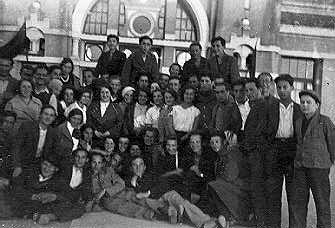
A group of "Chalutzim" from Germany with their local escorts at the Vilkovishk railway station before their departure to Eretz-Yisrael 1934
Sport activities were carried out at "Maccabi" with its 168 members, "Bar-Kochva", "HaPoel", "Betar", and the Yiddishists "Y.A.K", which included football, gymnastics, bicycle riding, swimming and table tennis.
Religion and Welfare.
The old synagogue and the other prayer houses which existed before the war, continued to fulfill their mission after most of Vilkovishk Jews returned home. All the societies for learning Judaism were active again as was the "Chevrah-Kadisha".
During all this period the Rabbi of the community was Eliyahu-Aharon Grin (1875-1941), who was murdered in the Holocaust.
After the disbanding of the community committee in the middle twenties, the welfare activities were transferred to the "Ezrah" society, which together with the "Adath Yisrael" society had about 120 members who donated about 500 Litas per year. These societies helped the poor, arranged fund raisings (as for "Maoth Chitim" for Pesach) and also initiated special welfare activities.
The pride of the community was its "Home for the Aged" which also had a nursing department. Its budget was covered by donations and by a regular allowance from the municipality (2,000 Lit. per year).
The "OZE" organization dealt mainly with Jewish school children, and its clinic was open twice a week. The municipality supported it with 2,400 Lit. per year (1932).
The welfare institution "Maskil El Dal" who gave interest free loans to the needy, renewed its activity in 1918 at the initiative of J.M.Levinovitz, its director for many years.
The Community also cared for the Jewish soldiers who served in the infantry regiment stationed in Vilkovishk for Kosher food, especially during the Jewish holidays